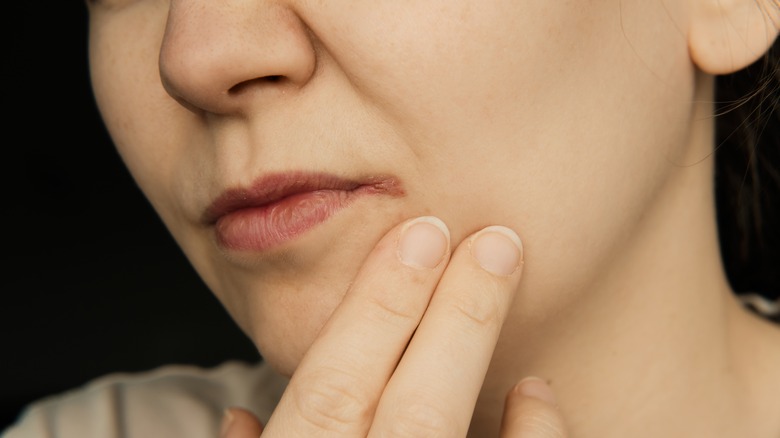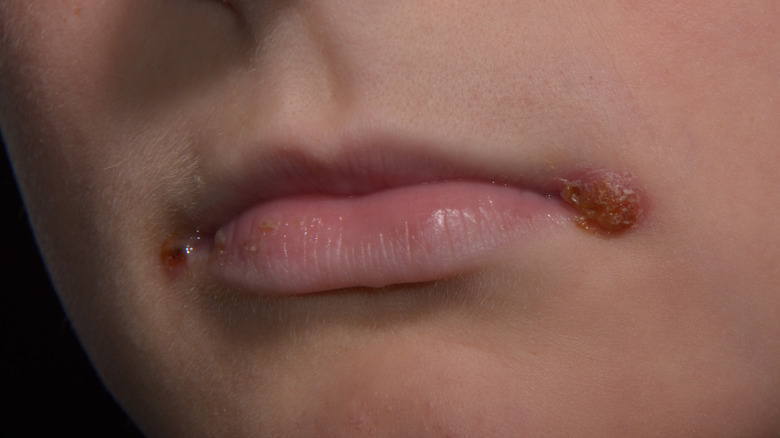The Blemishes You Get By Your Mouth Might Not Be Cold Sores After All
Our lips get a major workout every day. Between talking, eating, and kissing, we use them hundreds of thousands of times over the years without a second thought. But when lips become sunburned, bitten, dry, sore, or cracked, we notice it right away — and worry that others will, too. When unexplained blemishes appear on the mouth, the first thing that comes to mind is cold sores and all they entail: pain, embarrassment, and a ban on kissing until the lesions go away. But if you notice cracking, bleeding, or blistering at the corners of your mouth, it might actually be a condition called angular cheilitis.
Unlike cold sores, angular cheilitis isn't caused by a virus, but by excess dryness in the area where the lips join. While cold sores are usually preceded by a tingling sensation before the sore appears, angular cheilitis makes itself known through irritation in the corners that gradually gets worse. People with pronounced lines in that area are more likely to develop it, as are people with Down syndrome. Environmental and dietary habits also play a part. While angular cheilitis is less worrisome than a cold sore, it's still a nuisance you want to avoid as much as possible. Fortunately, you can.
Angular cheilitis is unsightly but not contagious
The National Institutes of Health defines angular cheilitis as "an inflammatory skin process of variable etiology occurring at the labial commissure" which "leads to saliva-induced maceration of the structurally susceptible epithelium." Um, what? For us non-doctors, that means the corners of the mouth have thinner skin than the rest of the lips and are especially prone to dryness. Excess salivating creates that drying effect, leading to inflammation, cracking, and sometimes infection from bacteria that collects in the open skin. "Cheilitis" comes from the Greek chilos, meaning "lips," and the "angular" part comes from the diagonal appearance of the mouth corners.
Anyone can develop angular cheilitis, though it's more common in people who are prone to drooling (such as teething infants or people with dentures). It can also be an underlying symptom of conditions such as diabetes, thrush, or HIV. The Cleveland Clinic adds that other factors, such as stress, smoking, and weight loss can bring on the cracks. Whatever the cause, the condition can be painful as well as unsightly, especially if blisters and scabs develop. And who wants to go around saying, "It's not a cold sore! It's angular cheilitis!" every time someone stares at your mouth?
Proper diet and lip care can prevent the condition
If you're experiencing symptoms of angular cheilitis for the first time — or if your case seems to be more severe than usual — it's best to see your doctor. A professional can help determine the cause of the cracking and offer an effective treatment. If bacteria or fungus is present, says dermatologist Sonia Batra, M.D. (via Men's Health), you may need an antibiotic, antifungal medication, or prescription steroid cream to clear up your lips. For milder cases, the Cleveland Clinic recommends soothing the area with petroleum jelly, lip balm, or ice. Until your lips feel better, avoid irritating your mouth with spicy foods or alcohol-based mouthwashes. No need to worry about kissing or sharing utensils, since angular cheilitis isn't contagious.
To prevent those ugly cracks, eating a healthy diet is one key; a B vitamin deficiency can make you more susceptible to lip ailments. Staying hydrated is also important, so keep your water bottle handy! If you smoke, consider this your motivation to stop or cut back. Gently removing accumulated dry skin can help keep your mouth in top shape, too — but be careful not to over-exfoliate your lips, which can cause even more irritation and bleeding. If your angular cheilitis is related to a dental issue such as braces, night guards, or dentures, consult your dentist. Thankfully, angular cheilitis goes away after a week or two, so your smile will be back to its glorious self before long.


